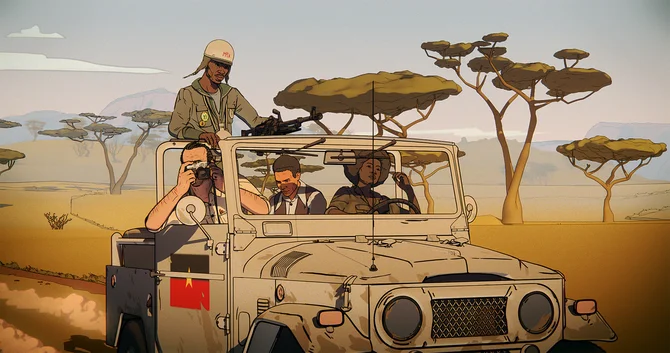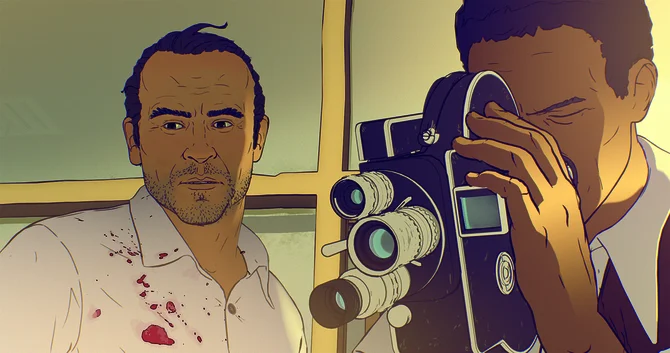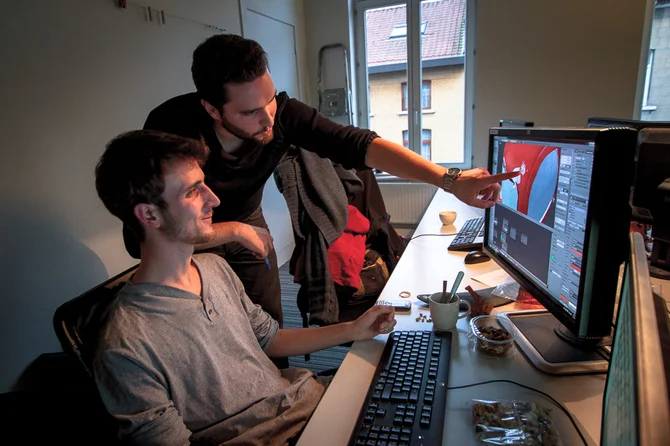How filmmakers in five countries came together to make a part-live action, part-animated film based on Another Day of Life, Ryszard Kapuściński’s first-hand account of the civil war in Angola…
In September 1975, the Polish journalist Ryszard Kapuściński, who by then had been covering the world’s trouble spots for a decade, paid his first visit to Angola, where a murderous civil war was being fought between two former liberation movements, UNITA and the FNLA.

Exposed to constant danger, he travelled through the country for three months, describing his experiences in a book, Another Day of Life, published the following year. Now, almost 40 years later, that book is being turned into a film which ambitiously combines live-action, motion-capture and traditional animation footage. Starting out as a Spanish/Polish co-production, it is due for delivery in the autumn of next year, two-and-a-half years after production began.
“From day one it was always envisaged as a hybrid film incorporating live action images and an animation story,” explains Ole Wendorff-Østergaard, a Danish producer who moved to Warsaw in 2008, just as the final pieces in the financing of Lars Von Trier’s Antichrist were being assembled. He married, settled there and joined animation house Platige. “When we started writing the story, we were hoping it would be 50/50, but it soon became apparent that the story we wanted to make was a character arc of Kapuściński which we couldn’t realise in live-action. It meant we had a need to go for 75% animation, and the cost jump in that meant that we needed to include more countries.’
The European funding bodies that work really well are the ones where you don’t hear anything. No news is excellent news when you are a delegate producer!
A five-way production
Joining Platige and Spain’s Kanaki Films, the latter the originator of the project, were Germany (Wüste Film) and Flemish animation house Walking The Dog, with additional motion-capture work done by Cologne-based Animationsfabrik. “Hungary is also in,” notes Wendorff-Østergaard, “so it’s actually five countries but a four-way coproduction, because they couldn’t raise the full 10%. We got permission from the Polish Film Institute and the Hungarian Film Institute to include them in the Polish side of the financing, because there is also Hungarian tax money in it.”
Polish filmmaker Damian Nenow shares the directing with Spain’s Raúl de la Fuente. “We don’t like to say there is a live-action director and an animation director,” says Wendorff-Østergaard, “but there was a need for two directors working together. This, of course, creates a new financing opportunity because you have a Spanish director and a Polish director, so the film funds support us more than if it was a minority co-production. And as we are 75% animation, we qualify throughout the world - all festivals - as an animation film. This is important because otherwise we would be put into a documentary pocket, which is a very thin one to get into.

From day one it was always envisaged as a hybrid film incorporating live-action images and an animation story.
A many-layered cake
Walking The Dog were brought in because of their impressive track record and their experience in handling co-productions where work is being done in several different locations. “There are many layers in our animation cake,” says Wendorff-Østergaard. “The concept art was done here [in Poland], in Hungary and in Germany. The pre-visualisation was also done here, in Germany and in Hungary. And then all the more technically complicated work – the compositing, lighting, shading and rendering - is being done in Flanders.” Walking The Dog, the company’s co-founder Eric Goossens explains, is particularly experienced in what is known as ‘the pipeline’.

“The whole structure from the beginning to the end needs to be set up so that all the partners can connect at the right moment with the right software and the right naming of all the data,” he says. “If you don’t work out this pipeline from the beginning, it becomes a nightmare.”
Walking The Dog’s other significant contribution to Another Day of Life, of course, was access to additional funding, which they raised from Screen Flanders, the Flanders Audiovisual Fund (VAF) and the Belgian Tax Shelter - a process which, says Wendorff-Østergaard, has gone very smoothly. “It has been really wonderful. The Tax Shelter is a tested institution which has existed now for around seven or eight years. I’ve worked with other tax funds when they were just up and running, and to get a clear answer out of them is sometimes difficult. We have not experienced these problems in Belgium and, while I’m not in direct contact with the VAF and Screen Flanders, I’ve had enough dealings with European funding bodies as part of my financing schemes to know that the ones that work really well are the ones where you don’t hear anything. No news is excellent news when you are a delegate producer! It means that things are running like they should. The requests that we have had for delivering material have been straightforward normal business procedures. It’s been working excellently.”